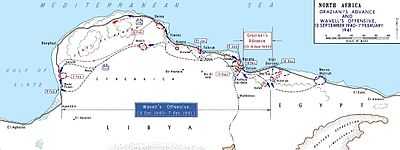Combe Force
| Combe Force | |
|---|---|
|
British pursuit 9 December 1940 – 7 February 1941 | |
| Active | February 1941 |
| Country | Britain |
| Branch | Army |
| Role | Flying column |
| Commanders | |
| Notable commanders | Lieutenant-Colonel J. F. B. Combe |
| ||||||
Combe Force or Combeforce, was an ad hoc flying column formed by the Western Desert Force to cut across the desert chord of the Jebel Akhdar in Cyrenaica and trap the retreating 10th Army, which was travelling along the coast road, Litoranea Balbo (Via Balbia).
Combe Force
In early December 1940, the British launched the Operation Compass raid against the Italian 10th Army, which had conducted the Italian invasion of Egypt in September 1940. The Italians advanced to Sidi Barrani and established defensive positions in a line of fortified camps, which were overrun during the raid. The scope of Compass was extended and the Italian garrisons in Bardia and then Tobruk were isolated and captured. By February 1941, the remaining Italian forces in Cyrenaica were withdrawing down the Via Balbia with the 7th Armoured Division and the 6th Australian Infantry Division close behind.[1]

At dawn on 4 February, the 11th Hussars left Mechili over ground which had not been reconnoitred by ground forces, to avoid alerting the Italians. Low-flying air reconnaissance had reported that the going was difficult and for the first 50 miles (80 km) the route was the worst yet encountered. By 3:00 p.m. armoured cars had reached Msus, 94 miles (151 km) away, where the garrison left hurriedly and some cars followed up another 30 miles (48 km) to Antelat. By dawn on 5 February, the rest of the division had reached Msus. Creagh had been informed of air reconnaissance that the 10th Army was retreating and O'Connor ordered that the advance be pressed to cut off the Italian retreat. Creagh decided to send Combe Force ahead, to block the Via Balbia between Benghazi and Agedabia as quickly as possible and to follow on to the south-west with the tracked vehicles, rather than westwards to Soluch.[2]
Combe Force reached Antelat during the morning and by 12:30 p.m. had observers overlooking the Via Balbia west of Beda Fomm and Sidi Saleh, about 32 kilometres (20 mi) north of Ajedabia and 48 kilometres (30 mi) south-west of Antelat, with the rest of the force following on. An Italian convoy drove up about thirty minutes later and was engaged by the artillery, anti-tank guns and armoured cars and was thrown into confusion, many prisoners being taken. In the afternoon, the Rifle Brigade got across the Via Balbia, despite Italian resistance and for the rest of the day, 10th Army columns arrived and made piecemeal attacks, losing many more vehicles and prisoners.[3]
Order of battle
- 11th Hussars
- 2nd Rifle Brigade, from the 7th Support Group
- C Battery 4th Royal Horse Artillery (RHA) with Ordnance QF 25 pounder guns, from the 7th Support Group
- 106th (Lancashire Hussars) Regiment RHA with nine Bofors 37 mm anti-tank guns portée (mounted on the back of lorries).[4]
See also
Footnotes
- ↑ Walker 2003, p. 64.
- ↑ Playfair et al. 1954, pp. 357–358.
- ↑ Playfair et al. 1954, p. 358.
- ↑ Macksey 1971, p. 135.
References
- Macksey, Major Kenneth (1971). Beda Fomm: The Classic Victory. Ballantine's Illustrated History of the Violent Century, Battle Books 22. New York: Ballantine Books. ISBN 0-345-02434-6.
- Playfair, Major-General I. S. O.; with Stitt RN, Commander G. M. S.; Molony, Brigadier C. J. C. & Toomer, Air Vice-Marshal S. E. (1954). Butler, J. R. M., ed. The Mediterranean and Middle East: The Early Successes Against Italy (to May 1941). History of the Second World War, United Kingdom Military Series I. London: HMSO. OCLC 888934805.
- Walker, Ian W. (2003). Iron Hulls, Iron Hearts: Mussolini's Elite Armoured Divisions in North Africa. Marlborough: Crowood. ISBN 1-86126-646-4.
